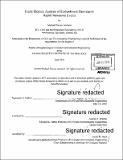Finite element analysis of embankment dam due to rapid drawdown events
Author(s)
Archard, Michael Steven
DownloadFull printable version (16.14Mb)
Other Contributors
Massachusetts Institute of Technology. Department of Civil and Environmental Engineering.
Advisor
Andrew J. Whittle.
Terms of use
Metadata
Show full item recordAbstract
The stability of large earth embankment dams is imperative for public safety and economic reasons. Among the numerous potential failure modes (which range from internal erosion to overtopping) slope instabilities can be triggered by changing boundary conditions associated with flood loading or rapid drawdown (RDD) conditions. The assessment of slope stability under RDD conditions is difficult to estimate due to the time-dependence of pore pressures within the dam and uncertainties in the shear strength properties of compacted fills. Computational analysis tools such as non-linear finite element methods allow for more comprehensive analyses than can be accomplished by conventional steady seepage and limit equilibrium methods and enable more detailed investigations of the underlying material properties and boundary conditions affecting earth dam performance. This thesis describes the use of finite element (FE) analyses to evaluate the effects of rapid drawdown on slope stability for a large, earth embankment dam, 'CV dam', located in Central New York State that was constructed in the 1960s. Hydraulic properties of the embankment fill are evaluated by fitting measurements of pore pressures inside the dam with 2-D steady seepage using the PLAXIS 2D 2015TM finite element program. Using these calibrated properties, slope stability is computed using the same program through the method of c-phi reduction using undrained and transient pore pressure conditions for a range of reservoir drawdown events. The results show how stability of the upstream slope can be related to the time-dependent drawdown of the reservoir. Instantaneous undrained drawdown generates the lowest factors of safety, while transient analyses provide a more realistic estimate of the operative factor of safety. The results confirm that there is adequate safety against slope stability for the full range of proposed drawdown events in the reservoir.
Description
Thesis: M. Eng., Massachusetts Institute of Technology, Department of Civil and Environmental Engineering, 2016. Cataloged from PDF version of thesis. Includes bibliographical references (pages 54-55).
Date issued
2016Department
Massachusetts Institute of Technology. Department of Civil and Environmental EngineeringPublisher
Massachusetts Institute of Technology
Keywords
Civil and Environmental Engineering.